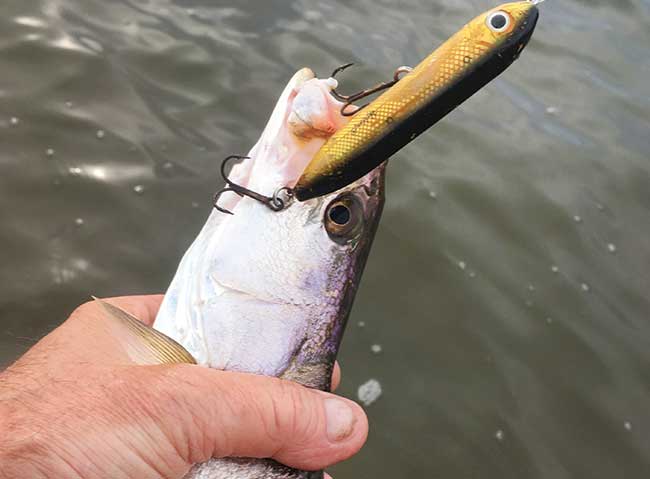By Richard Matteson
The water is warming, and the fish are chomping. Summer is here, and the topwater bite is on.
I fished the Indian River Lagoon recently and caught seven trout—three longer than 22 inches—and four snook, with two longer than 24 inches, plus two jacks. I was using a gold Zara Spook Jr., and the trout and snook were going crazy, blasting the lure in the air.
On one cast, I had 10 hits and didn’t get a fish hooked. I use a Spook with a swish-swish-pop motion called “walking the dog.”
Last June, I caught 11 trout over 22 inches in the lagoon near Vero on a good morning. My largest trout was nearly 10 pounds and 30 inches. I also lost a bigger one, but that’s fishing. I was using a Rapala Skitterwalk in trout color.
Along with walking baits, the other main topwater plugs are poppers. They make more noise and can draw fish to the lure quickly from a distance.
For every fish you hook, there will be several misses. The trick to fishing topwater is to count to three slowly when you see or hear the strike. Do not apply too much pressure or you’ll pop the lure off, just keep steady pressure with no slack in the line.
Some of the smaller topwater plugs have thin treble hooks. You can change them out with heavier hooks that won’t bend or break as easily but still give the right action.
Fishing topwater requires long casts. Using braided line with a fluorocarbon leader allows better contact with the lure. After the cast, I let the lure sit for a couple seconds before retrieving. Then, I keep the lure moving at a steady walk so the fish can find it.
An erratic retrieve means more misses, and the trouble with topwater fishing is getting good hookups. The best thing is to see the water explode, and remember, do not set the hook. Count to three and start retrieving. If the fish missed the fist time, it will often go after it again. So it’s important not to pull the lure away. Leave it there and twitch it a couple times.
Once you have the fish on, keep your rod tip low or even put it underwater a couple inches. This keeps the fish from jumping and throwing the lure.
Always check your leader for abrasion and your lure’s hooks after each catch. Sometimes the hooks will be bent or the leader worn. I use a loop knot which allows better movement of the topwater plug. Look for birds, bait and especially feeding fish. Fish shallower on higher tides and back off the shore on low tide.
Tie on a topwater today, and watch the water explode. It’s one of the best ways to catch fish inshore.
Richard Matteson is the Stuart Rod and Reel Club staff writer. To contact the Stuart Rod & Reel club, visit www.stuartrodandreel.com or call 336-414-3440.

